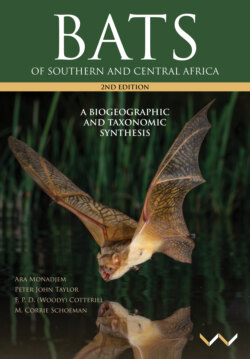Читать книгу Bats of Southern and Central Africa - Ara Monadjem - Страница 8
На сайте Литреса книга снята с продажи.
INTRODUCTION
ОглавлениеBats show a remarkable variety of adaptations to their environment and consequently vary considerably in size, appearance, and morphology. For example, the world’s smallest bat, the 2 g Craseonycteris thonglongyai (Figure 1) from Thailand, is 600 times smaller than Pteropus vampyrus, which weighs up to 1.2 kg and has a wingspan of 1.8 m (Jones 1996). Bats occur worldwide, except in extreme polar and desert habitats. The species diversity of bats is highest in equatorial regions, notably in tropical forests, with progressively fewer species encountered with increasing latitudes in temperate climates (Schoeman et al. 2013, Herkt et al. 2016).
Figure 1. The skull of the world’s smallest living bat, the tiny bumblebee bat, Craseonycteris thonglongyai (right), next to those of two of Africa’s largest insectivorous bats, Macronycteris gigas (bottom) and Scotophilus alvenslebeni (top). Scale bar = 10 mm (© F. P. D. Cotterill).
The oldest known bat fossil, Onychonycteris finneyi, was discovered recently in fossil beds in Wyoming, USA, and dates to 52 million years ago. Its diagnostic characters are intermediate between bats and non-flying mammals (Simmons et al. 2008). The fossil bat species had claws on each finger and relatively long hind legs in relation to its forelimbs, similar in ratio to sloths and lemurs. Its short, broad wings indicate that it probably alternated between flapping flight and gliding, and that it was also capable of clambering in trees. The small cochlea (ear) bones show that it could not echolocate, suggesting that flight evolved before echolocation in bats. By 50 million years ago, during the Eocene, there were already at least three families and 13 species of bats. Eocene fossil bats are known from North America, Europe and Australia. All these ancestors were already fully developed as bats, although they did not closely resemble extant species. Recent discoveries in Egypt of extinct bats from the late Eocene and early Oligocene (37–27 million years ago), which appear more closely related to modern species, suggest that bats may have diversified in Africa following migration of primitive ancestors from Europe (Gunnell et al. 2008).
Taxonomic classifications are essential to the universal communication of verifiable scientific knowledge (Cotterill 1995a, Ghiselin 2005), in which descriptions of species, and any other taxon, should adhere to scientific conventions of nomenclature (Winston 1999, Gardner and Hayssen 2004). In this respect, the persisting confusion over the real species diversity of African house bats (genus Scotophilus) testifies to why precise and accurate taxonomy is so critical to all of biology and conservation. This example especially highlights the relevance of type material, preserved in museums, if we are to apply scientific evidence to clarify the distinctiveness of a population in a taxonomic revision. Thus, where our own research on collections or published evidence allows, we have detailed respective type material (the holotype, syntype or lectotype) for each of the 125 species in the species accounts section, which also discusses related taxa of biogeographical relevance, where the status of synonyms and purported subspecies is currently unresolved in relation to the nominate taxon. Nevertheless, this book does not provide an exhaustive synonymy, for which full taxonomies are available (Meester et al. 1986, Ansell 1989, Simmons 2005).
Selected from among several competing alternatives, the concept of the species category has radical impacts on how biodiversity is classified. With respect to the diversity of living bats, the taxonomic treatment of Simmons (2005) is based primarily on a Phylogenetic Species Concept (PSC), as an operational criterion of the Evolutionary Species Concept (ESC) (see Cotterill 2002a, Cotterill et al. 2014 and Taylor et al. 2019a for discussion). Different choices of species concept have significant consequences on a taxonomy, and thus any facet of knowledge of a group of organisms. Although the authors of this book are not in total agreement on the scientific relevance of the subspecies concept, we have recognised phylogenetically distinct populational lineages as specifically distinct; we have highlighted existing microtaxonomic problems in this context. Where listed, the subspecies category serves to flag populations of current uncertain taxonomic status, which await revision using modern taxonomic methods and molecular evidence (Cotterill et al. 2014, Taylor et al. 2019a).
The most recent published list of mammalian species (Burgin et al. 2018) recognised 1,386 species of bats in the world (up from 1,115 species reported in the 2010 edition of this book); this is one-fifth of the total 6,495 mammalian species listed. Since the publication of the list, the total number of bats has increased to 1,411 species, according to the database maintained by Burgin and colleagues (Mammal Diversity Database 2019). In a different database, dedicated to listing all the bat species in the world, the number of species now sits at 1,406 (Simmons and Cirranello 2019). We expect this number to continue increasing for the foreseeable future.
This book presents the most comprehensive account, to date, of the bats of southern Africa, and is an update of the first edition, published in 2010. This synthesis of knowledge is underpinned by extensive specimen collections housed in southern Africa, as well as in overseas museums. We have compiled species accounts for the 125 species of bats known to occur in the southern African region. This synthesis of knowledge is accompanied by identification matrices, distribution maps, sonograms, photographs of bats and their skulls, and tables of measurements.
